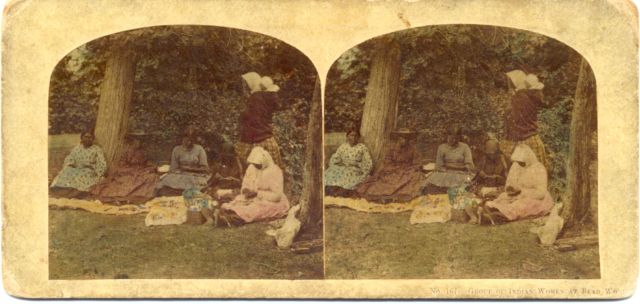In bright light, glass beads sparkle like magic. The 16th century Iroquois who first traded for European glass beads must have been impressed by their beauty and magical qualities. Prior to the introduction of glass beads, the Indians made beads out of bone, antler, stone, shell, quills, and pottery sherds. None exhibited the special qualities of glittering glass beads in a rainbow of brilliant colors.
The earliest European glass beads to reach Iroquoia are thought to have been traded up the Susquehanna River from Spanish trading posts further south. For centuries the beads were used mainly for personal ornamentation, but by the late 18th century, beads were used to decorate items meant for sale or trade. Pincushions, needle cases, pocket watch holders, mats, wall pockets, and purses were the first beaded commercial items made in quantity by Iroquois women in the early 19th century. By the end of the century, they were also making picture frames, match holders, scissors holders, glasses holders, boot and shoe shaped pieces, trilobe heart hanging pincushions, hanging urns, table boxes, whisk broom holders, model canoes, strawberries, birds, dolls, appliqués, horseshoe good luck wall hangers, and card holders.
Not all makers of Iroquois beadwork were Iroquois women. Often relatives and friends from other reservations made crafts for Iroquois merchants who marketed the pieces, especially at Niagara Falls, where they were usually identified merely as Indian. Many Indian families have been supported mainly by the income from the sales of their beadwork. Besides beadwork, other items such as baskets and wood carvings were sold.
Iroquois women, and a few men, continue to produce beautiful pieces of Iroquois beadwork. Although beadworkers live on all of the reservations, the majority live on the Tuscarora Reservation near Niagara Falls and on the Kahnawake reserve near Montreal. Often they use patterns passed down from their 19th century ancestors. A 19th century tradition continues into the 21st.
The back of the stereo card says “Group of Indian Women at Bead Work. Scene on Goat Island, Niagara.”
“Goat Island during the summer season is much frequented by vendors of souvenirs of the Falls, for few can pay a visit her without carrying away some little article of curiosity as a remembrance thereof; hence those who keep shop “under the shade of the greenwood tree,” drive a considerable and profitable trade. Amongst them the Indian women are conspicuous, as seated on the sward they curiously contrive purses, pincushions, needle-books, slippers, caps, and other numerous articles in elegant bead work, which for beauty of design and neatness of execution is unsurpassed. In the neighbourhood of Niagara in times past, ere the white face set foot upon their territory were the hunting grounds, of the Seneca Indians, and it is the remnant of this scattered tribe that gains a subsistence by the manufacture and sale of fancy articles upon the ground where at one time the tribe held undisputed sway. About four miles from Niagara, is a small Indian village, where the old laws and customs of this people are still observed to a limited extent, the inhabitants electing their chief and looking up to him as the patriarch of the flock.”
